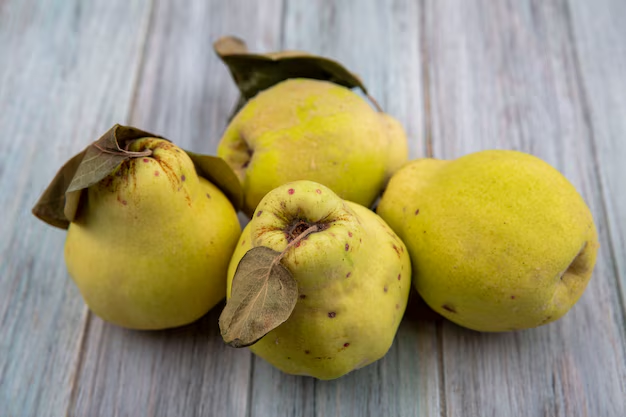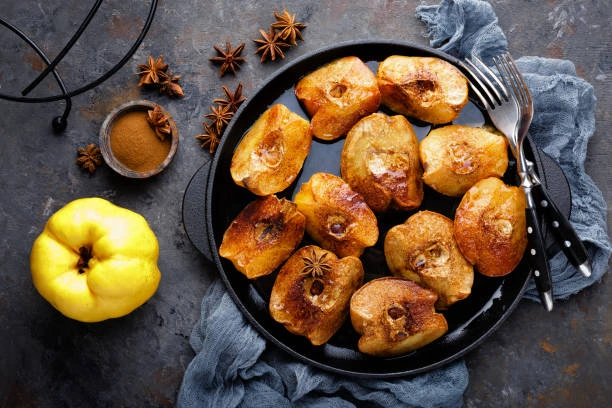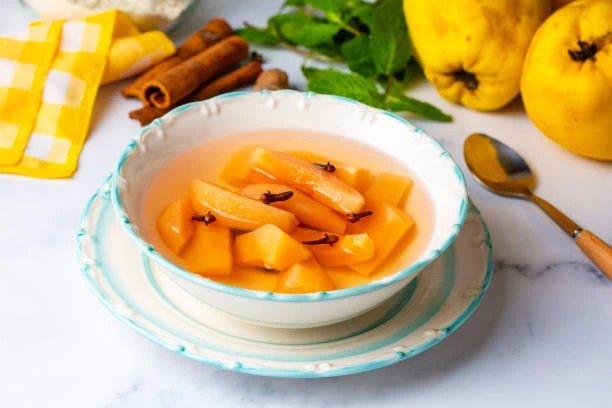The quince fruit (Cydonia oblonga) is often overlooked in favor of more common fruits like apples and pears, but this ancient fruit is packed with nutrients and health benefits that make it worthy of a place in your diet. Not only is it a boon for your health, but it also comes with eco-friendly perks, making it a smart choice for anyone seeking sustainable, nature-conscious food options.
In this blog, we’ll dive into the impressive benefits of quince fruit and explore how it can contribute to a healthier lifestyle and a healthier planet.
What is Quince Fruit?

Quince is a hard, yellow fruit that looks similar to a pear but is typically much firmer. Unlike other fruits, quince is rarely eaten raw due to its tartness and astringency. However, when cooked, it transforms into a tender, fragrant fruit with a deliciously sweet flavor, often used in jams, jellies, sauces, and desserts.
Native to the Mediterranean region, quince has been cultivated for thousands of years, cherished for both its unique taste and its medicinal properties. It’s now grown in various parts of the world, from Europe to Asia to North America.
Nutritional Benefits of Quince
1. Rich in Antioxidants
Quince is an excellent source of antioxidants, particularly flavonoids and phenolic compounds. These antioxidants help fight free radicals in the body, reducing inflammation and lowering the risk of chronic diseases such as heart disease and cancer. By incorporating quince into your diet, you can boost your immune system and protect your cells from oxidative stress.
2. High in Dietary Fiber
Quince is a rich source of dietary fiber, which plays a crucial role in digestive health. Consuming fiber regularly helps regulate bowel movements, prevent constipation, and promote a healthy gut microbiome. Quince’s fiber also helps you feel fuller for longer, aiding in weight management and reducing overeating.
3. Supports Heart Health
The fiber and antioxidant properties of quince can contribute to cardiovascular health. Studies have shown that quince can help lower blood cholesterol levels, reduce blood pressure, and improve overall heart function. A diet rich in fruits like quince is a natural way to maintain heart health and prevent the onset of heart disease.
4. Boosts Immune Function
Quince is a good source of vitamin C, an essential nutrient that supports immune function. Vitamin C helps the body fight off infections, aids in collagen production, and supports the absorption of iron. Regular consumption of quince can help keep your immune system strong, especially during cold and flu season.
5. Improves Skin Health
The antioxidants and vitamins found in quince, especially vitamin C, can also benefit your skin. Quince’s anti-inflammatory properties can reduce skin irritation, while its antioxidants can help combat the effects of aging, including wrinkles and fine lines. Incorporating quince into your diet can lead to a healthier, more radiant complexion.
Environmental Benefits of Quince Fruit
In addition to its health benefits, quince fruit offers several environmental advantages. Here’s why adding quince to your eco-friendly lifestyle can help make a difference:
1. Low Water Footprint
Quince trees are well-adapted to dry conditions and require less water than many other fruit crops, such as apples and peaches. This makes quince a more sustainable option for agriculture, especially in regions facing water scarcity. By choosing quince, you are supporting crops that have a lower environmental impact in terms of water usage.
2. Less Pesticide Use
Quince trees are relatively pest-resistant and often require fewer pesticides compared to more conventional fruit crops. This makes quince a more environmentally friendly option for farmers, reducing the use of harmful chemicals that can pollute waterways and harm local ecosystems.
3. Biodiversity Friendly
Quince trees are a great addition to agroforestry systems, as they can thrive in a variety of soils and climate conditions. Growing quince in mixed orchards or alongside other plants can contribute to biodiversity by creating diverse habitats for insects, birds, and other wildlife. Supporting quince farming helps promote agricultural biodiversity, which is key to sustaining healthy ecosystems.
4. Sustainable Sourcing
As demand for sustainable, locally grown produce increases, quince has the potential to be a viable crop in regions where other fruits may not thrive. Its hardiness and adaptability make it a great option for farmers seeking to diversify their crops while reducing their carbon footprint.
How to Incorporate Quince Fruit Into Your Diet
Quince is versatile and can be enjoyed in many different ways. Here are some ideas on how to incorporate this nutrient-packed fruit into your diet:
1. Quince Jam or Jelly

A popular way to enjoy quince is by making it into jam or jelly. Pair it with toast, yogurt, or cheese for a sweet and tangy snack.
2. Baked Quince

Baking quince with a sprinkle of cinnamon and honey creates a warm, aromatic dessert that’s both healthy and delicious.
3. Quince Compote

Simmer quince with a bit of sugar and lemon juice to create a compote that can be used as a topping for pancakes, waffles, or oatmeal.
4. Quince Tea

In some cultures, quince is used to make a refreshing tea, often enjoyed for its soothing properties.
5. Quince in Salads

Cooked or roasted quince can be added to salads for a unique flavor profile, pairing well with leafy greens, goat cheese, and nuts.
Final Thoughts
Quince may be an ancient fruit, but its health benefits and environmental advantages make it a modern superfood worthy of our attention. Packed with antioxidants, fiber, and essential nutrients, quince supports immune function, heart health, and healthy skin. Moreover, its sustainable cultivation practices make it an eco-friendly fruit that aligns with the principles of environmental conservation.
By incorporating quince into your diet, you’re not just nourishing your body—you’re also supporting sustainable agricultural practices that help protect the planet. Whether you’re enjoying quince as a jam, compote, or in a savory dish, this versatile fruit offers a wealth of benefits for both you and the environment.
So, the next time you’re at the market or looking for a new fruit to try, consider reaching for quince. It’s a small change that can make a big impact on your health and the planet!
If you’re interested in other eco-friendly food choices or sustainable living tips, make sure to subscribe to our newsletter for more content that supports a healthy, green lifestyle!
